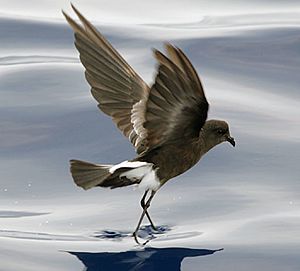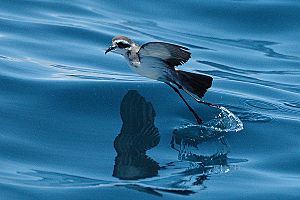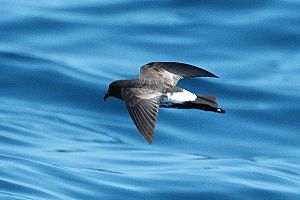Austral storm petrel facts for kids
Quick facts for kids Austral storm petrels |
|
|---|---|
 |
|
| Wilson's storm petrel (Oceanites oceanicus) | |
| Scientific classification |
|
| Kingdom: | Animalia |
| Phylum: | Chordata |
| Class: | Aves |
| Order: | Procellariiformes |
| Family: | Oceanitidae Forbes, 1881 |
| Genera | |
|
|
Austral storm petrels, also called southern storm petrels, are tiny seabirds. They belong to the Oceanitidae family, which is part of a larger group called Procellariiformes. These birds are the smallest seabirds in the world!
They eat tiny sea creatures like plankton and small fish. They usually pick their food right off the water's surface while hovering. Their flight looks like a butterfly's or even a bat's, with lots of quick wing beats.
Austral storm petrels live all over the world's oceans. You can find them in every ocean, but only a couple of species, like the Wilson's storm petrel and white-faced storm petrel, are seen in the Northern Hemisphere. They spend almost all their lives at sea. They only come to land when it's time to lay eggs and raise their young.
These birds nest in groups, often returning to the exact same spot where they were born. Most species nest in small cracks or burrows in the ground. They usually visit their nesting sites at night to stay safe from predators. Pairs stay together for many years. Both parents share the job of incubating the egg and feeding the chick. Raising a chick takes a long time for these birds. It can take up to 50 days for the egg to hatch and another 70 days for the chick to be ready to fly.
There are ten different species of austral storm petrels. They are grouped into five different types, called genera. Sadly, some of these species are endangered because of human activities. For example, the New Zealand storm petrel was thought to be extinct until it was seen again in 2003. The biggest danger to storm petrels comes from introduced species, especially mammals like rats and feral cats. These animals are brought to the islands where the birds nest. Storm petrels usually nest on isolated islands where there are no predators. This means they can't protect themselves from these new dangers.
Contents
What Are Austral Storm Petrels?
The Oceanitidae family, which includes austral storm petrels, was named in 1881 by a scientist named William Alexander Forbes. Long ago, storm petrels were divided into two main groups. The austral storm petrels (Oceanitinae) mostly lived in the southern parts of the world. The northern storm petrels (Hydrobatinae) mostly lived in the Northern Hemisphere.
Up and down! - up and down!
From the base of the wave to the billow’s crown,
And amidst the flashing and feathery foam
The stormy petrel finds a home, -
A home, if such a place may be
For her who lives on the wide, wide sea.
O’er the deep! - o’er the deep!
Where the whale and the shark and the sword-fish sleep, -
Outflying the blast and the driving rain,
The petrel telleth her tale — in vain!
Scientists have studied the DNA sequence of these birds. This research suggests that austral storm petrels are a very old group within the Procellariiformes order. This means they were one of the first groups to split off from the main family tree. Not many fossils of these birds have been found. The oldest ones are from about 5 to 23 million years ago.
How Do Storm Petrels Look and Fly?
Austral storm petrels are the smallest seabirds. They are usually between 15 and 26 centimeters long. They have short wings, square tails, and long legs. Their legs are longer than other birds in their group. However, their legs are very weak. They can only take a few steps on land.
Most austral storm petrels have dark feathers with white undersides. The Wilson's storm petrel is an exception. It has dark feathers all over. Sometimes, it can be hard to tell different species apart. Even experts can mix them up in photos.

Storm petrels have cool ways of flying and finding food. Many species feed by "pattering" on the water. They hold their feet on the surface and hover above the water. They flap their wings very fast or use the wind to stay still. This is how austral storm petrels often eat. The white-faced storm petrel has a special way of pattering. It holds its wings still and angled into the wind. Then, it pushes itself off the water in a series of bouncy jumps. Storm petrels also use the wind to glide over the ocean. They can gain height by turning into the wind. Then, they glide back down to the sea.
What Do Storm Petrels Eat?
It's hard to study what many storm petrel species eat. This is because they spend so much time at sea. But generally, they seem to eat mostly crustaceans. These are small sea creatures like tiny crabs or shrimp. They also eat small fish and tiny molluscs. Some species are pickier. For example, the grey-backed storm petrel mainly eats the young forms of goose barnacles.
Almost all storm petrels find their food in the open ocean. The only exception is Elliot's storm petrel. These birds feed closer to the coast around the Galapagos Islands. Even though storm petrels can swim well, they don't usually eat while in the water. They prefer to eat while flying. They hover or "walk" on the water's surface. Then, they snatch up small bits of food. Sometimes, they might make a quick, shallow dive under the water to catch prey.
Like many other seabirds, storm petrels sometimes hunt with other animals. They might follow seals or penguins. These animals dive deep and push prey up towards the surface. This makes it easier for the storm petrels to grab food from the top of the water.
Where Do Storm Petrels Live and Travel?
Austral storm petrels usually breed in the Southern Hemisphere. This is different from northern storm petrels, which breed in the Northern Hemisphere.
Many storm petrel species travel long distances after they finish breeding. The Wilson's storm petrel is one of the biggest travelers. After breeding in Antarctica and nearby islands, it often flies across the equator. It travels all the way to the waters of the north Pacific and Atlantic Oceans. Some species, like the grey-backed storm petrel, don't travel far. They stay close to their breeding islands all year.
How Do Storm Petrels Breed?
Storm petrels nest in large groups, called colonies. Most of them nest on islands. A few species, however, breed on the mainland, especially in Antarctica. They visit their nesting sites at night to avoid predators. Storm petrels are very loyal to their birthplaces. They return to the same colony to breed. One band-rumped storm petrel was even found nesting just 2 meters from where it was born!
Storm petrels make their nests in burrows they dig in soil or sand. They also use small cracks in rocks. There can be a lot of competition for nesting spots. Other burrowing birds, like shearwaters, have been known to kill storm petrels to take over their burrows. Some colonies are huge and packed with birds. For example, on South East Island in the Chatham Islands, there are 840,000 pairs of white-faced storm petrels nesting very close together.
Storm petrels are monogamous. This means they have one partner and stay together for many years. Like other birds in their group, they lay only one egg per breeding season. If the egg doesn't hatch, they usually don't try to lay another one. Both parents take turns sitting on the egg. They switch every few days. The egg hatches after about 40 to 50 days. The chick is kept warm constantly for about 7 more days. After that, it's left alone in the nest during the day. The parents feed it at night by bringing up food from their stomachs.
The food given to the chick is about 10-20% of the parent's body weight. It includes small prey and a special oily liquid called stomach oil. Stomach oil is full of energy. It helps the chicks grow quickly. This is important because the parents can only visit the chick once every 24 hours (at night). The chicks are ready to fly when they are between 50 and 70 days old. This is a long time for such small birds. But it's normal for seabirds, which live longer and have fewer young. The young birds leave their burrow around 62 days old. They become independent right away and fly out to sea. They return to their birth colony after 2 or 3 years. But they don't start breeding until they are at least 4 years old. Some storm petrels have been known to live for 30 years!
Why Are Storm Petrels Threatened?
Several species of austral storm petrels are in danger because of human activities. The New Zealand storm petrel is listed as critically endangered. It was even thought to be extinct for many years. But it was seen again in 2003. However, its population is likely still very small. Storm petrels face similar dangers as other seabirds. They are especially threatened by introduced species. These are animals like rats and cats that are brought to their nesting islands.
Species of Austral Storm Petrels
There are ten species in the austral storm petrel family:
| Image | Common name | Scientific name | Where they live |
|---|---|---|---|
 |
Wilson's storm petrel | Oceanites oceanicus | South Shetland Islands |
 |
Elliot's storm petrel | Oceanites gracilis | Galápagos Islands, Peru and Chile |
| Pincoya storm petrel | Oceanites pincoyae | Chile | |
 |
Grey-backed storm petrel | Garrodia nereis | Antarctica, Argentina, Australia, Chile, Falkland Islands, French Southern Territories, New Zealand, Saint Helena, South Africa, and South Georgia and the South Sandwich Islands. |
 |
White-faced storm petrel | Pelagodroma marina | Australia, New Zealand, Cape Verde Islands, Canary Islands and Savage Islands. |
 |
White-bellied storm petrel | Fregetta grallaria | Angola, Argentina, Australia, Brazil, Chile, Ecuador, French Polynesia, French Southern Territories, Maldives, Namibia, New Zealand, Perú, Saint Helena, and South Africa. |
 |
Black-bellied storm petrel or Gould's storm petrel | Fregetta tropica | Antarctica, Argentina, Australia, Bouvet Island, Brazil, Chile, Falkland Islands, French Polynesia, French Southern Territories, Madagascar, Mozambique, New Zealand, Oman, Peru, Saint Helena, São Tomé and Príncipe, Solomon Islands, South Africa, South Georgia and the South Sandwich Islands, Uruguay, and Vanuatu. |
 |
New Zealand storm petrel | Fregetta maoriana | Coromandel Peninsula of New Zealand's North Island, |
| New Caledonian storm petrel | Fregetta lineata | New Caledonia and Australia | |
| Polynesian storm petrel (including white-throated storm petrel) | Nesofregetta fuliginosa | Chile, French Polynesia, Kiribati, New Caledonia, Vanuatu, possibly American Samoa |
See Also
- List of Procellariiformes by population


